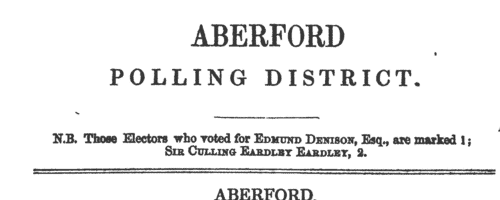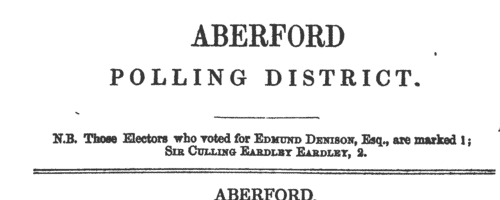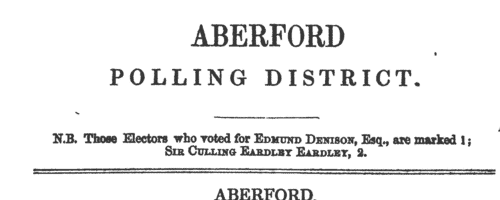Waud Surname Ancestry ResultsOur indexes 1000-1999 include entries for the spelling 'waud'. In the period you have requested, we have the following 106 records (displaying 51 to 60): Single Surname Subscription | | | Buying all 106 results of this search individually would cost £562.00. But you can have free access to all 106 records for a year, to view, to save and print, for £100. Save £462.00. More... |
These sample scans are from the original record. You will get scans of the full pages or articles where the surname you searched for has been found. Your web browser may prevent the sample windows from opening; in this case please change your browser settings to allow pop-up windows from this site. Insolvents in England and Wales
(1847)
Perry's Bankrupt and Insolvent Gazette, issued monthly, included lists of insolvencies and stages in the process whereby the insolvents petitioned for release from debtors' prison. The insolvent is generally referred to by name (surname first), address and trade. This is the index to the names of the insolvents, from the issues from January to December 1847.WAUD. Cost: £6.00.  | Sample scan, click to enlarge

| Electors for Camblesforth
(1848)
On 14 and 15 December 1848 an election took place for a Knight of the Shire for the West Riding of Yorkshire in the House of Commons. The candidates were Edmund Denison and sir Culling Eardley Eardley, gaining 14,743 and 11,795 votes respectively. The county franchise at this period included freeholders of land worth 40s or more a year; £10 copyholders and long-leaseholders; and £50 short-leaseholders and tenants. This poll book was published in 1849.
Former poll books had been compiled from the sheriff's returns; but as these were now transmitted to the Home Office immediately after an election, in this instance the polling was marked from the check-clerk's returns, carefully compared with the registers marked in the poll booths at the time of voting.
The votes for the respective candidates are indicated by the numerals 1 (Denison) and 2 (Eardley). The omission of these numerals indicates that the elector did not vote. Many names which appear on the register of particular townships are completely omitted in this poll book: in all these cases, the same name will be found recorded in some other township, the elector having two or more qualifications. In such cases, his name only appears in the poll book in the actual township for which he chose to vote; or, if he did not vote at all, in that township for which he was qualified that lay closest to his actual residence.
The townships are arranged alphabetically within polling district; and within each township the names are arranged alphabetically by surname and christian name, and the elector's residence is given. Many of the electors resided outside the township for which they were qualified - some in other counties. Moreover, at the end of each polling district there is a list of persons registered to poll in that district, from townships is other districts. WAUD. Cost: £4.00.  | Sample scan, click to enlarge

| Electors for Carlton (near Snaith)
(1848)
On 14 and 15 December 1848 an election took place for a Knight of the Shire for the West Riding of Yorkshire in the House of Commons. The candidates were Edmund Denison and sir Culling Eardley Eardley, gaining 14,743 and 11,795 votes respectively. The county franchise at this period included freeholders of land worth 40s or more a year; £10 copyholders and long-leaseholders; and £50 short-leaseholders and tenants. This poll book was published in 1849.
Former poll books had been compiled from the sheriff's returns; but as these were now transmitted to the Home Office immediately after an election, in this instance the polling was marked from the check-clerk's returns, carefully compared with the registers marked in the poll booths at the time of voting.
The votes for the respective candidates are indicated by the numerals 1 (Denison) and 2 (Eardley). The omission of these numerals indicates that the elector did not vote. Many names which appear on the register of particular townships are completely omitted in this poll book: in all these cases, the same name will be found recorded in some other township, the elector having two or more qualifications. In such cases, his name only appears in the poll book in the actual township for which he chose to vote; or, if he did not vote at all, in that township for which he was qualified that lay closest to his actual residence.
The townships are arranged alphabetically within polling district; and within each township the names are arranged alphabetically by surname and christian name, and the elector's residence is given. Many of the electors resided outside the township for which they were qualified - some in other counties. Moreover, at the end of each polling district there is a list of persons registered to poll in that district, from townships is other districts. WAUD. Cost: £6.00.  | Sample scan, click to enlarge

| Electors for Horton
(1848)
On 14 and 15 December 1848 an election took place for a Knight of the Shire for the West Riding of Yorkshire in the House of Commons. The candidates were Edmund Denison and sir Culling Eardley Eardley, gaining 14,743 and 11,795 votes respectively. The county franchise at this period included freeholders of land worth 40s or more a year; £10 copyholders and long-leaseholders; and £50 short-leaseholders and tenants. This poll book was published in 1849.
Former poll books had been compiled from the sheriff's returns; but as these were now transmitted to the Home Office immediately after an election, in this instance the polling was marked from the check-clerk's returns, carefully compared with the registers marked in the poll booths at the time of voting.
The votes for the respective candidates are indicated by the numerals 1 (Denison) and 2 (Eardley). The omission of these numerals indicates that the elector did not vote. Many names which appear on the register of particular townships are completely omitted in this poll book: in all these cases, the same name will be found recorded in some other township, the elector having two or more qualifications. In such cases, his name only appears in the poll book in the actual township for which he chose to vote; or, if he did not vote at all, in that township for which he was qualified that lay closest to his actual residence.
The townships are arranged alphabetically within polling district; and within each township the names are arranged alphabetically by surname and christian name, and the elector's residence is given. Many of the electors resided outside the township for which they were qualified - some in other counties. Moreover, at the end of each polling district there is a list of persons registered to poll in that district, from townships is other districts. WAUD. Cost: £6.00.  | Sample scan, click to enlarge

| Deaths, Marriages, News and Promotions
(1850)
Death notices and obituaries, marriage and birth notices, civil and military promotions, clerical preferments and domestic occurrences, as reported in the Gentleman's Magazine. Mostly from England and Wales, but items from Ireland, Scotland and abroad.
WAUD. Cost: £4.00.  | Sample scan, click to enlarge

|  Inhabitants of Newington in Surrey
(1851) Inhabitants of Newington in Surrey
(1851)
The 1851 census return for St Mary Newington, Surrey, registration district: St Peter Walworth sub-district: enumeration district 22: described as: "All that Part of the Parish of St. Mary Newington, which Comprises East St. (North side) to John St., John St. (both sides) Including Tatums Place, Tatums Court, Ballards Yard, Woods Buildings, & Aldred Place to boundary". This area lay in the ecclesiastical district of St Peter Walworth, and in the borough of Lambeth. HO 107/1567. The addresses listed in the actual returns are East Street (six households); 1 to 4 Smiths Buildings, East Street; 1 to 12 Bedford Row; 1 to 17 Woods Buildings (including tan yard); 1 to 18 Alfred Place; 1 to 6 Sion Place; 1 to 21 and 36 to 44 John Street (including yards); 1 to 3 Tatum's Court; 3 to 6 Woods Buildings; 1 to 3 Ballards Yard; Park Place; 2 to 13 Tatum's Place; and 1 to 14 Ludbroke Place.WAUD. Cost: £4.00.  | Sample scan, click to enlarge

|  Inhabitants of Southwark in Surrey
(1851) Inhabitants of Southwark in Surrey
(1851)
The 1851 census return for St George the Martyr, Southwark, registration district: London Road sub-district: enumeration district 1: described as: "Bridge House Place, commencing at No 1 to the end - Borough Road (left hand) to the corner, Cuthbertson's - Southwark Bridge Road (left hand) to the house beyond Clark's Timber Yard - The opposite side of Southwark Bridge Road No 172 to Broom's Yard inclusive and both sides of Great Union Street from Southwark Bridge Road to Bridge House Place". This area lay in the parish of St George the Martyr, Southwark. The addresses listed in the actual returns are 1 to 52 Bridge House Place, 1 to 13 Borough Road (including Stones End, Portland Place and Atlas Works), 1 to 30 and 156 to 172 Southwark Bridge Road (including Brooms Yard), 1 to 19 Great Union Street.WAUD. Cost: £4.00.  | Sample scan, click to enlarge

|  Inhabitants of Southwark in Surrey
(1851) Inhabitants of Southwark in Surrey
(1851)
The 1851 census return for St George the Martyr, Southwark, registration district: London Road sub-district: enumeration district 3: described as: "Market St commencing at 'Dog & Stile) (both sides) to Coss (Zinc Worker, opposite Clark's Timber Yard - Providence Place - George St & Passage - Saint George's Row - Parliament Street - St George's Market including Butcher Row - London Road No 92 (Catholic Nunnery) to the 'Duke of Clarence' both inclusive - & Borough Road to Apps inclusive, corner of Mansfield St." This area lay in the parish of St George the Martyr, Southwark. The addresses listed in the actual returns are 17 to 42 and 46 to 50 Market Street, 45, 172 and a half and 173 Southwark Bridge Road, 1 and 2 Market Street, 1 to 4 Providence Place, 8 to 23 Butcher Row, 1 to 12 George Street, 1 Falconer's Court, 1 to 5 George(s) Passage, 3 to 17 (St) Georges Row, 2 to 4, 6, 7, 13 and 16 Parliament Street, 1 to 7 and 26 St George's Market, 92 to 132 London Road (including the Catholic convent), and 1 to 8 Borough Road.WAUD. Cost: £4.00.  | Sample scan, click to enlarge

| Traders and professionals in London
(1851)
The Post Office London Directory for 1851 includes this 'Commercial and Professional Directory', recording about 80,000 individuals. WAUD. Cost: £4.00.  | Sample scan, click to enlarge

| Patentees of New Inventions
(1852-1853)
Abstracts of British patents for new inventions applied for and granted from 1 October 1852 to 31 December 1853: giving date, name and address, and short description of the invention. It is then stated whether 'Letters patent sealed' or 'Provisional protection only'.WAUD. Cost: £6.00.  | Sample scan, click to enlarge

|
Research your ancestry, family history, genealogy and one-name study by direct access to original records and archives indexed by surname.
|













